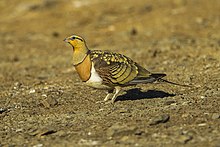Columbimorphae
| Columbimorphae | |
|---|---|
 | |
| Classificazione scientifica | |
| Dominio | Eukaryota |
| Regno | Animalia |
| Phylum | Chordata |
| Classe | Aves |
| Clade | Columbaves |
| Clade | Columbimorphae Latham, 1790 |
| Clade | |
Columbimorphae è un clade scoperto dall'analisi del genoma che comprende gli uccelli degli ordini Columbiformes (piccioni e colombi), Pteroclidiformes (grandule) e Mesitornithiformes (mesena).[1] Anche le precedenti analisi avevano recuperato questo raggruppamento,[2][3][4] sebbene le relazioni esatte differiscano. Alcuni studi indicano una stretta relazione tra grandule e piccioni (la visione tradizionale)[3][5][6], mentre altri studi preferiscono invece un gruppo gemello di mesena e grandule.[1][4]
| Columbimorphae |
| ||||||||||||
Note
[modifica | modifica wikitesto]- ^ a b E.D. Jarvis, Whole-genome analyses resolve early branches in the tree of life of modern birds, in Science, vol. 346, n. 6215, 2014, pp. 1320–1331, DOI:10.1126/science.1253451, PMC 4405904, PMID 25504713.
- ^ P. G.P Ericson, C. L Anderson, T. Britton, A. Elzanowski, U. S Johansson, M. Kallersjo, J. I Ohlson, T. J Parsons, D. Zuccon e G. Mayr, Diversification of Neoaves: integration of molecular sequence data and fossils, in Biology Letters, vol. 2, n. 4, 2006, pp. 543–547, DOI:10.1098/rsbl.2006.0523, PMC 1834003, PMID 17148284.
- ^ a b S. J. Hackett, R. T. Kimball e S. Reddy, A Phylogenomic Study of Birds Reveals Their Evolutionary History (PDF), in Science, vol. 320, n. 5884, 2008, pp. 1763–1768, DOI:10.1126/science.1157704, PMID 18583609. URL consultato il 26 marzo 2019 (archiviato dall'url originale il 12 aprile 2016).
- ^ a b T. Yuri, Parsimony and Model-Based Analyses of Indels in Avian Nuclear Genes Reveal Congruent and Incongruent Phylogenetic Signals, in Biology, vol. 2, n. 1, 2013, pp. 419–444, DOI:10.3390/biology2010419, PMC 4009869, PMID 24832669.
- ^ BRADLEY C. LIVEZEY e RICHARD L. ZUSI, Higher-order phylogeny of modern birds (Theropoda, Aves: Neornithes) based on comparative anatomy. II. Analysis and discussion, in Zoological Journal of the Linnean Society, vol. 149, n. 1, 2007, pp. 1–95, DOI:10.1111/j.1096-3642.2006.00293.x, PMC 2517308, PMID 18784798.
- ^ Gibb, Gillian C., and David Penny. "Two aspects along the continuum of pigeon evolution: A South-Pacific radiation and the relationship of pigeons within Neoaves." Molecular Phylogenetics and Evolution 56.2 (2010): 698-706.
Altri progetti
[modifica | modifica wikitesto] Wikimedia Commons contiene immagini o altri file su Columbimorphae
Wikimedia Commons contiene immagini o altri file su Columbimorphae Wikispecies contiene informazioni su Columbimorphae
Wikispecies contiene informazioni su Columbimorphae
